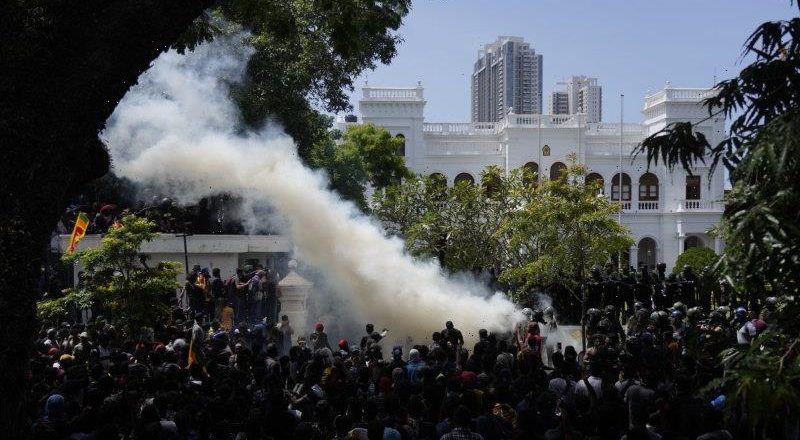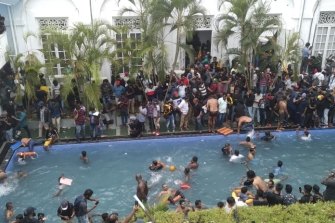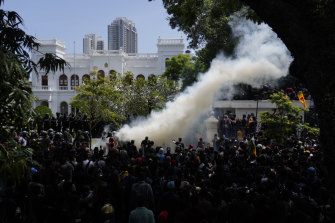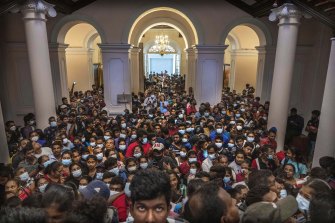People power has brought down Sri Lanka’s ruling dynasty. What now?
Delhi: Protest movements produce powerful symbols. Images of the citizens of Sri Lanka storming the presidential residence of the man who steered their country into financial ruin and then refused to step down sent a pointed message. When they started swimming in Gotabaya ’s pool, cooking in his kitchen and working out in the official gym, he had to know it was over for his family’s reign of economic destruction.
For the first time since demonstrations began in March in the capital, Colombo, soldiers were seen joining the protests. So too were the Buddhist monks who had previously helped propel the Rajapaksas to government.
Protesters say they had not realised how expansive the presidential palace was.Credit:AP
When the military starts to turn against the strongman who was once defence secretary, it’s clear the power has finally shifted — though they are still out in force on the streets and there’ve been reports of violence against protesters and journalists that’s put some in hospital.
That the weekend was dominated by reports the Rajapaksas were planning to flee the country was not surprising given the renewed ferocity of the protesters now driven not just by anger but desperation. The president left his residence before it was seized and his whereabouts were, for a while, unknown. He said he was preparing to resign on Wednesday. His citizens said that was not soon enough.
Then just before he was due to hand in his resignation, he fled the country with his wife and two bodyguards aboard a Sri Lankan Air Force plane bound for Male, the capital of the Maldives.
Sri Lanka has been in financial crisis for months. There is no fuel, essential medicines are either unavailable or in short supply and food inflation is running at close to 80 per cent. Initial talks with the International Monetary Fund wrapped up on June 30, but there is no immediate resolution to the foreign exchange crisis that has brought the nation to a standstill. About a quarter of the 22 million population is unsure of where their next meal will come from, the World Food Program said on July 6.
The people have spoken. They have been telling their government for months to resign. The signs at the permanent protest site along Colombo’s waterfront overwhelmingly read “Gota, go home”.
When former leader Ranil Wickremesinghe stepped in two months ago to steady the administration (beginning his sixth term as prime minister) and start negotiating in earnest with the IMF, the people were not convinced. And they were right — whatever answers he may have had, he was viewed as part of the political establishment that had led Sri Lanka to this point. Hours after Wickremesinghe said on Saturday he too was prepared to leave his post, protesters set fire to his private residence, a move widely condemned by the broader civilian uprising.
On Wednesday, several hundred people surrounded his office in Colombo trying to breach the compound past police in riot gear, climbing the fences, to demand his resignation. He responded by declaring a curfew and state of emergency.
Travelling through the Rajapaksa’s stronghold of Hambantota last month in the island’s deep south, it was clear then that even the family’s diehard supporters were losing faith. Gotabaya’s decision to ban the importation of fertilisers last year – the country had intended to embrace organic agriculture as a point of difference – cost farmers at least two harvests and left them with little means of survival. It plunged the country into a food crisis from which it will take years to recover.
Police use tear gas as Sri Lankan protesters storm the compound of prime minister Ranil Wickremesinghe’s office, demanding he resign after president Gotabaya Rajapaksa fled with his wife to the Maldives.Credit:AP
So what is next?
The IMF said it hoped for a resolution to Sri Lanka’s political turmoil to allow a resumption of bailout talks after the fury of Saturday’s protests. The US called on the parliament in Colombo “to approach this juncture with a commitment to the betterment of the nation — not any one political party,” a State Department spokesperson said during Secretary of State Antony Blinken’s visit to the region.
The problem is, only the protesters seem to be moving with any sense of urgency; the parliament should appoint an all-party cabinet that includes technocrats with deep economic experience to guide the nation out of this government-induced emergency.
People throng President Gotabaya Rajapaksa’s official residence in Colombo, Sri Lanka, for the second day after it was stormed on Saturday.Credit:AP
They need to do this quickly — before a potentially dangerous power vacuum develops that could allow extremist groups to exploit the instability. It is only three years since the Easter Sunday bombings in Colombo that were claimed by supporters of the Islamic State. Churches and luxury hotels were targeted, killing nearly 270 people and crippling the tourism industry.
If there’s one thing these protesters have shown, it is that the Rajapaksas can be defeated. That the corruption and human rights abuses they are both famous and feared for, can be overcome, however long that process may be. It’s important to remember that beyond their grave economic mismanagement, Gotabaya’s administration, and his brother Mahinda’s before him, repeatedly blocked any legal avenues for accountability over the grave abuses linked to the 26-year civil war that ended under their watch in 2009.
Instead, as Human Rights Watch notes, victims of past abuses, their families, journalists and human rights defenders have endured surveillance and intimidation. Muslims, Tamils, and other minorities have faced discrimination and threats. Many have been severely beaten. Some have disappeared. The brothers have repeatedly denied any link to the violence.
What’s different now is that all these groups have come together to oust the Rajapaksas. They have rejected the family’s brand of populist authoritarianism that relied on the support of Sinhalese Buddhists, who make up 75 per cent of the population. They are united in their desire for a peaceful and prosperous Sri Lanka that can resist politicians’ attempts to divide communities and incite violence. It’s time for their own political leaders — and the international community — to heed their call and help them as they forge a new future for their country.
Ruth Pollard is a Bloomberg Opinion editor. She is a former South and South-East Asia government team leader at Bloomberg News, and Middle East correspondent for The Sydney Morning Herald.
Bloomberg
Get a note directly from our foreign correspondents on what’s making headlines around the world. Sign up for the weekly What in the World newsletter here.
Most Viewed in World
From our partners
Source: Read Full Article




